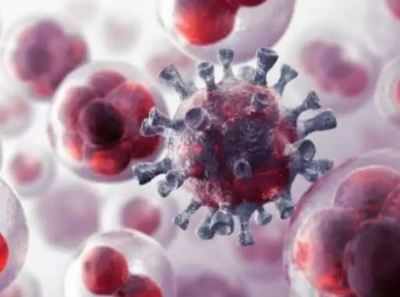- News
- Science News
- Chinese scientists develop nanozymes to target cancerous tumour cells
This story is from April 19, 2018
Chinese scientists develop nanozymes to target cancerous tumour cells
In what could be a breakthrough in treatment of cancer, a team of Chinese researchers have for the first time developed a strategy to control and coordinate nanozymes to selectively target and kill cancerous tumour cells.

Representative image.
BEIJING: In what could be a breakthrough in treatment of cancer, a team of Chinese researchers have for the first time developed a strategy to control and coordinate nanozymes to selectively target and kill cancerous tumour cells.
Nanozymes, nanomaterials with intrinsic enzyme-like activities, have been widely used in diagnosis of cancer in recent years, but controlling their performance in treating a target tumour cell remains a challenge.
A research team, jointly led by Yan Xiyun from the Institute of Biophysics under the Chinese Academy of Sciences and Gao Lizeng from Yangzhou University, has for the first time developed a strategy to coordinate nanozymes to target tumour cells and selectively kill tumours, state run Xinhua news agency reported today.
Their findings were published in Nature Communications last week. Nature Communications is an open access journal that publishes high-quality research in biology, physics, chemistry, Earth sciences, and all related areas.
This situation reduces the effect of chemotherapy.
If the accumulated H2O2 can be combined with oxygen to be converted into a toxic reactive oxygen species, this may enable more effective means of tumour therapy, according to Yan.
Previously, natural enzymes were used, however, they were less sensitive and not as stable, so enzyme mimics or artificial enzymes were developed, but the efficiency of enzyme mimics was often insufficient.
Therefore, the team has developed a nanozyme which has shown excellent bio-compatibility, the report said.
To optimise its performance for tumour therapy, scientists used ferritin, an intracellular protein found in most human tissue, to modify the surface of the nanozymes to enable them to target tumours.
Tests demonstrated that ferritin-modified nanozymes suppressed tumours in animal models, and proved the feasibility of using nanozymes for tumour therapy, it said.
"If modified, nanozymes can function as Trojan horses, transporting cell-destroying compounds into tumour cells," Yan was quoted as saying by Xinhua.
Nanozymes can be fine-tuned via size, dosage, and surface modification. In addition, they have multiple functions, high stability, and are easy to scale up at a low cost, according to the study.
"We hope this nanozyme-based tumour therapy can enable new strategies for cancer treatment," Yan said.
Nanozymes, nanomaterials with intrinsic enzyme-like activities, have been widely used in diagnosis of cancer in recent years, but controlling their performance in treating a target tumour cell remains a challenge.
A research team, jointly led by Yan Xiyun from the Institute of Biophysics under the Chinese Academy of Sciences and Gao Lizeng from Yangzhou University, has for the first time developed a strategy to coordinate nanozymes to target tumour cells and selectively kill tumours, state run Xinhua news agency reported today.
Their findings were published in Nature Communications last week. Nature Communications is an open access journal that publishes high-quality research in biology, physics, chemistry, Earth sciences, and all related areas.
During tumour growth and development, elevated levels of hydrogen peroxide (H2O2) are often exhibited in solid tumours, which render tumour cells more resistant to therapeutic treatment, it said.
This situation reduces the effect of chemotherapy.
If the accumulated H2O2 can be combined with oxygen to be converted into a toxic reactive oxygen species, this may enable more effective means of tumour therapy, according to Yan.
Previously, natural enzymes were used, however, they were less sensitive and not as stable, so enzyme mimics or artificial enzymes were developed, but the efficiency of enzyme mimics was often insufficient.
Therefore, the team has developed a nanozyme which has shown excellent bio-compatibility, the report said.
To optimise its performance for tumour therapy, scientists used ferritin, an intracellular protein found in most human tissue, to modify the surface of the nanozymes to enable them to target tumours.
Tests demonstrated that ferritin-modified nanozymes suppressed tumours in animal models, and proved the feasibility of using nanozymes for tumour therapy, it said.
"If modified, nanozymes can function as Trojan horses, transporting cell-destroying compounds into tumour cells," Yan was quoted as saying by Xinhua.
Nanozymes can be fine-tuned via size, dosage, and surface modification. In addition, they have multiple functions, high stability, and are easy to scale up at a low cost, according to the study.
"We hope this nanozyme-based tumour therapy can enable new strategies for cancer treatment," Yan said.
End of Article
FOLLOW US ON SOCIAL MEDIA
